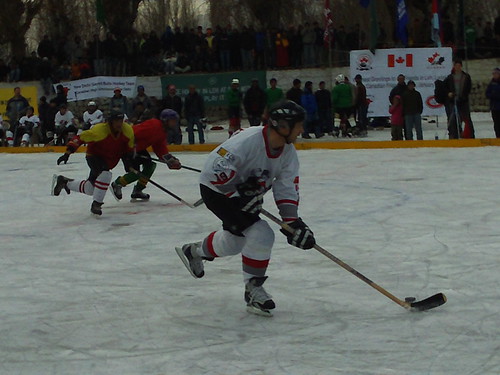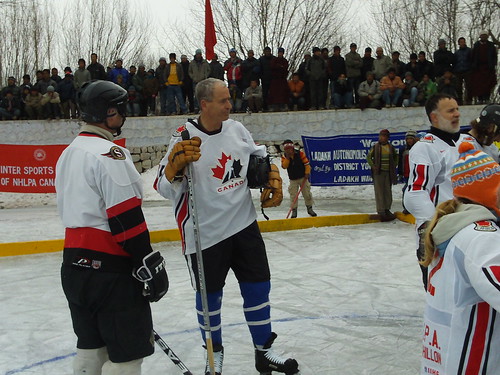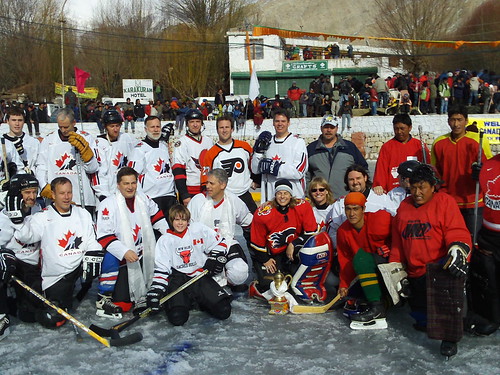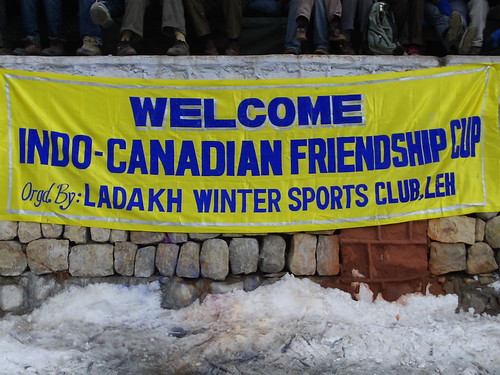
This posting is in conformity with the rest of this blog, but the post is easily modifiable for a newspaper article. Pictures will not be posted to this article until at least February 19, due to poor internet in Ladakh. In the meantime, you can check out pictures on my Flickr account: Anyway...enjoy...
In my apparent ego-centrism, narcissism and ignorance, I wrongly assumed that I was the Christopher Columbus of ice hockey in Ladakh. “I have discovered hockey in Ladakh,” I said to myself in my head, but like Columbus in regards to America, many had come before me. Obviously, hockey was being played in Ladakh, and has been for some time. It became logical, seeing as all you needed was some ice and hockey equipment. People that came here for hockey over the years brought it with them, which solved that riddle.
So many sports stories begin with who beat whom and which player performed the best. We hear about the rivalry of sports and see the behavior of fans as crude, ignorant or violent. But what gets lost in the shuffle is how sports can bring people together.
For almost a decade now, members of the Canadian High Commission (Embassy) in Delhi have been coming up to Leh, Ladakh in the Indian state of Jammu and Kashmir. They have been participating in a friendly tournament, the Indo-Canadian Friendship Cup, with local hockey teams, and have been bonding over the sport of ice hockey in the only region in India where ice forms naturally.
This was news to me. At the onset of the 4th National Ice Hockey Tournament, I was informed that a team of Canadians was coming. I had seen a sign around the rink thanking the NHLPA for their support of Ladakhi hockey, but was completely stunned to learn that a bunch of players would come up from Delhi when it’s a beautiful 70°F (approx 23°C), year in and year out, tough out altitude sickness, and share their happiness as well!
Furthermore, the national tournament stopped. Completely. Play would resume once the Canadian team left.
Tony Kretzschmar, who used to work for an engineering company in Delhi, has been participating in the tournament since its inception. He now works in Shanghai, but set aside time in his schedule every year to visit one of the most remote regions in the world.
For your benefit, here is a full quote from Tony:
"I have had the distinct privilege of seeing the game of hockey develop in Leh since 2001. When I think back to the way they use to play back then, using field hockey sticks, old rusty skates, very little equipment, and even less understanding of the rules of the game, I feel a great sense of pride in seeing the teams play today. The progress has been heartwarming, and it was nice to see the games against Canadian teams not only resulting in Canadian domination...they actually beat us a few times in the championship over the years. However the goal of our annual Canadian team visits is not to win, it's more about hockey diplomacy and developing the game for the benefit of the children. The social aspect has grown out of what started out as a high adventure pure sporting initiative. I must say this is truly what brings me back and drives me to work on connecting the many folks around the world who want to help."
The games are always close in these competitions. The Canadian (and a few American) players don’t have much opportunity to play hockey while stationed in India, and their brief trip into an altitude of nearly 12,000 feet (about twice that of Denver, or three times that of Calgary) make it nearly impossible for the players to over-exert themselves. Air is thin, and breath becomes short.
Manitoba native Casey Guenther, a teacher at Woodstock International School in a relatively nearby state of Uttarakhand (nothing is nearby Ladakh in the Winter), was one of the top players on the Canadian team. He and his wife had visited Leh in the Summer of 2008 and “…fell in love with the place, but it’s the first time [coming here] in Winter.” A tall, lean player who looked to be in good shape, Casey, like so many others, had a hard time with the altitude. “Besides not being able to breath, it’s good. [My coming back now. It’s great. Hard to breath, but it’s fun.”
Over the years, the relationship between the Canadian High Commission team - only partially comprised of High Commission staff - has intensified. Each year, the team has donated equipment, and has increased awareness in Canada that has resulted in more equipment and resources to the Ladakh Winter Sports Club, including a skate sharpener, although I was informed that it took years to get this up and running, as it was a 110V North American style plug, and the converter needed was in Delhi. For a long time, nobody ever bothered to purchase it and bring it back to Leh.
Ego aside, I was delighted to hear about the Canadian team coming, and I made it a priority to meet the folks involved and get some good pictures, video and interviews. As usual, I quickly got absorbed into everything, and had met one of the members of the High Commission prior to the full team arriving and we had a nice chat over lunch. Once the tournament had begun, I made it over to the rink and struck up some conversation with family members of the team. They informed me that this was far and away the largest group to come up for the tournament, 47 – most being family & friends of the team.
The fans are active participants in these games. The crowd, expectant of fun hockey matches, was large and loud. No matter which team was with the puck, a deep roar would sweep the sunken, stone-lined rink whenever a top player on either team would touch the puck. Envision Alex Ovechkin on a shorthanded breakaway with 1 minute left in the 3rd period, in a tied playoff game 7.
Although many of them were admittedly out of shape, and all of them were having difficulty breathing, the High Commission team was able to hold off the J&K teams in consecutive competitions on Day 1, a Saturday. This was when I got most of my interviews with the team, and a handful of their players, including, Ken Macartney, the Deputy High Commissioner. “This is my third year in Ladakh,” said Ken, “and it’s fantastic…one of the most beautiful rinks in the world.” For Ken, it brought back nostalgic sentiments. “It’s a reminder of small town Canada. It’s a great experience and we look forward to it at the High Commission and in the [participating] Canadian community.”
The temperature had become increasingly warm during the days of these matches this year, with mid-day temperatures reaching about 1-2°C/33-35°F. As you know from your science classes from the days when you received some variety of education, ice melts at 0°C/32°F. The same is true at high altitude, where the sun shining down on a pond that continues to receive running water and is surrounded by heat-absorbing rocks brings the temperature above freezing. As the ice gets cut up in these conditions, it becomes increasingly dangerous. This is similar to what our American team dealt with in Kargil (Ice Hockey in Ladakh, Part 2 - Kargil Tournament).
Just like when the Chief Minister of Jammu and Kashmir attended the finals of the 4th National Ice Hockey Tournament, the Karzoo Ice Rink just a quarter mile away from the Main Bazaar (Main Street) of Leh began to sink under the weight of 2-3 times the normal capacity. Often times, a whole group of people had to pick up all of their gear and belongings, and shuffle off to a different portion of the rink. That is, until that section started to sink.
Last year, it was quite the opposite. Depending on your point of view, the weather was either great for hockey, or way too cold for civilization. Canadian goalie Sarah Finall, an employee of the Canadian High Commission, participated in her first tournament last year upon her posting to Delhi. According to Sarah, “this whole experience is fabulous, even though it was minus 30°C (about -25°F) last year and I nearly died!” Her sentiment regarding the experience of hockey in Leh and the hospitality of the Ladakhis was consistent throughout the group. “It’s something you don’t want to miss,” stated Sarah, “it’s so amazing. The Ladakhi people are so great and welcoming.” The altitude was just part of the experience for Sarah, “What an experience to come up and play hockey at this altitude!”
Rumor had come my way that there would be a banquet at the “Only star hotel in Ladakh” (think about that for a second), and while I had assumed that I would be able to attend that event, I was never given a formal invite, so a local friend, Henk Thoma (no, he’s not Ladakhi…he’s a Dutch transplant that I’ll tell you about in a future post) and I went back to SECMOL and watched their “State of the Campus” address. Each student was responsible for a particular responsibility at SECMOL, including management of the library, collecting money, ice-rink maintenance, and milking the cows. The judges of their presentations critiqued their poor presentation skills, and although most of what I said was under my breath to Henk, I was very disappointed when the winning presentation had endless typos and poor grammar. Especially since one of the presenters was a European that was there teaching English. Nonetheless, afterwards, the group got to relax and get to one of their favorite activities: singing along with Ladakhi music and dancing in a way reminiscent of MTV's, “The Grind”, circa 1994.
The next day, the final match between the Canadians and an All-Star J&K team commenced. But due to continued poor weather (in hockey terms), the game was called at the end of the second period with a tie-game. The fans in attendance were disappointed at the outcome, but when safety is concerned, I err on the side of being conservative (well, sometimes I do), and after a few injuries sustained to the players on the Canadian team, they felt it was in the best interest of self-preservation to stop the game.
After the game, I went into the office where the Ladakh Winter Sports Club camps out, and on one of the tables was my formal invitation to the banquet that was held the night before. As I spoke to the LWSC members during the day, they had asked why I wasn’t in attendance. “I didn’t know I was invited,” I replied. One of them told me that when he saw me walking in the Main Bazaar, he assumed I was heading to the hotel, even though they apparently had a car to take me. Oh well. That evening, it was more than made up for, and entirely on accident.
The previous week, when Akshay Kumar of the Ice Hockey Association of India had come to Leh, Henk and I met him at the same hotel for dinner, and we were both very impressed, as we were both accustomed to the traditional amenities of Leh and throughout Ladakh. Granted, I’ve only been here for a handful of weeks, but Henk has been living in Leh for over a decade. We had decided that we were going to treat ourselves to a nice dinner at the hotel and enjoy something different than rice and daal (lentils).
I guess in the back of our minds we knew there was a chance things would play out as they did. Upon our arrival at the hotel, we immediately ran into some of the folks from the Canadian entourage and the Ladakh Winter Sports Club. We were quickly invited into their banquet that was about to begin, and while I’m sure a handful of people were wondering how and when we got ourselves into this dinner, it was an innocent coincidence.
Fortunately, Henk and I already being familiar with the Ladakh Winter Sports Club and my previous interaction with the Canadian group, we easily interacted with everyone at the party. For me, this was one of the most significant and impactful moments of my trip to date. Everybody from this group was incredibly warm and kind-hearted, which immediately cancelled whatever apprehension was in the back of my mind, being a stranger and an American (it’s easy to feel judged on a hockey-level by Canadians). The hockey talk was enlightening!
I heard stories from all different people about the prior support that Ladakh has received in ice hockey, and it’s plenty! The first Canadian team played in Leh in 2001, opening the eyes of the population to the North American style of the game. Within a few years, Canadian press had covered hockey in Ladakh and India in a handful of specials, and a couple from Canada produced an award-winning documentary: “Hockey Night in Ladakh” to showcase the passion for the game in Ladakh.
In 2003, the NHLPA Goals and Dreams Foundation donated 50 sets of equipment to the Ladakh Winter Sports Club. Coaches from New Zealand came in 2004 and spent a month teaching ice hockey and figure skating. In 2005, money was set aside to start the construction of an indoor ice hockey rink in Leh. That rink has yet to break ground, but after this year’s national tournament, the Chief Minister f Jammu & Kashmir pledged twice as much money and vowed that the rink would be completed.
The Los Angeles Kings Junior coach also came in 2005 to coach, the same year a skate sharpener arrived, and the following year the Kings brought a Ladakhi team to Los Angeles. The coach of the team Ladakhi team was initially denied his visa to America, but after some maneuvering was able to get his visa and accompany his team to the States. He never returned to India. He’s somewhere in California, most likely the Los Angeles area, and is married to an American woman.
Beginning in 2007, the Montreal Canadiens have been supporting Health, Inc., a non-profit operating in rural Ladakh. They held coaching clinics in Ladakh, as well as donating equipment.
To find out all of this was overwhelming, but in the best of ways. I could not be more delighted to see how much support has been given to Ladakhis to improve their hockey, but there’s a flip side.
The longer I stay in Ladakh, and the more people I talk to about Ladakh, the more I have learned about the negative aspects of Ladakh. Sure, the people are very welcoming, and I have been treated with nothing but the utmost respect. At the same time, there is a pattern of staggered support - usually one season of coaching or donations - given to a culture that has their palms wide-open, and as a result, very little progress has been made. For nearly a decade now, people with the best of intentions come to Ladakh, fall in love with initial impressions and gorgeous scenery, and do what they can to help the people. The fact of the matter is that Ladakh is an area that receives a disproportional amount of government support because it’s a border territory, so the people need to be kept happy…or at least content. It has a large population that is uneducated and out of work, corruption is prevalent, and because tourism is the staple industry, Westerners are relied upon for their good graces and deep pockets.
At the end of the day, I am not here to fix a culture, nor do I want to. I’m also not blaming anyone, as I have also developed a love for Ladakh. That being said, I DO want to change the hockey culture here. The passion and love of the game that I felt from the Canadian group was as palpable as that of the Ladakhis, and I vowed to all of them that my only goal here is to tap into the passion for the game and help it grow. I voiced my desire to work with the Canadians next year, and hopefully join their team, and I know they are interested in holding their own hockey clinic here next winter, something that would break with a pattern of coming up for a couple of days, playing a few games, throwing some parties, and going back to life in Delhi or abroad.
I would like to see everyone involved in Ladakhi hockey to have a more focused, cooperative plan, this way we don’t take baby steps each winter, and see all of our work done for naught. Instead, with our sustained support, we can take giant leaps year-round. If we work together and strategize, we can do so much more to improve the quality of hockey in Ladakh, like training local coaches to train the local population.
Since my passion is hockey, I would do a disservice to myself, and everyone involved in the sport, if I didn’t share my concern and ideas for how we can share our mutual love for the game. The promising part is that I know everyone I’ve met here feels the same way about the game as I do, and with our mutual passion, anything can be accomplished! I can’t wait to get to work!










3 comments:
Hey Adam --
As ever, a GREAT read!
Keep on Puckin', Dude!
Best --
Mike
Adam,
Thanks for sharing so many of your experiences with us. Who would have thought that there has been so much history of hockey in that remote part of the world?
Are you ever going to come back? Just curious.
Hey Allan,
I just noticed this comment..sorry.
I am slated to return to the U.S. on April 29th, although if another country is interested in my services, I am more than happy to change my trip again!
That'll depend on continued fundraising as well.
Post a Comment